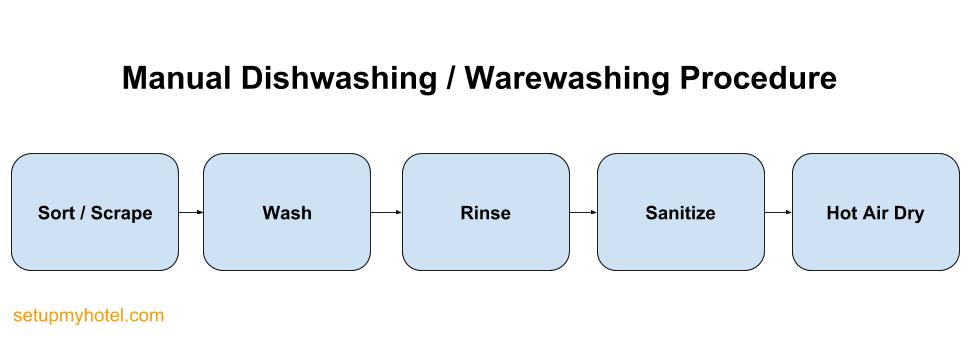Stewarding SOP for The Basics of Warewashing
In a busy kitchen, the dishwasher is often the unsung hero. However, without proper training and attention to detail, the kitchen’s entire operation can suffer. That’s why it is crucial for all kitchen stewards to understand the basics of ware washing.
First and foremost, it’s important to understand the three-compartment sink method. This involves using three separate sinks for washing, rinsing, and sanitizing. The washing sink should contain hot, soapy water, while the sanitizing sink should contain a solution of water and sanitiser. Additionally, it’s important to frequently change out the water in each sink, especially as it becomes dirty or contaminated.
Another key aspect of proper ware washing is understanding the importance of temperature. Water that is too hot can damage dishes, while water that is too cold may not effectively clean and sanitize them. It’s essential to follow manufacturer guidelines and recommended temperatures for both the washing machine and the three-compartment sink.
Lastly, kitchen stewards should be aware of the different types of dishwashing detergents and sanitizers available. Each kitchen may have unique needs depending on the types of dishes being used and the water quality in the area. By selecting the right products and following proper procedures, kitchen stewards can ensure that dishes are not only clean, but also safe for customers to use.
Overall, mastering the basics of warewashing is crucial for any kitchen steward. By following proper procedures and paying attention to detail, they can help keep the kitchen running smoothly and ensure that customers receive clean, safe dishes every time.
Establish standard policies for the proper procedure for washing and sanitizing kitchen equipment, kitchen utensils, and F&B service equipment to reduce microbiological contamination and chemical contamination to prevent proper cleaning concentration and contact time in the process.
The Executive Chef and Stewarding Manager should be responsible for ensuring that appropriate kitchen equipment cleaning and maintenance methods are followed by the stewarding staff. The hotel training and HRD department should develop and implement proper written Kitchen Stewarding SOP’s to ensure the same is implemented correctly throughout all the food preparation outlets.

1. What is the standard procedure for manual pot/ware washing?
Note: This SOP is for reference or example only, always follow the instructions provided by the manufacturer for your’s and others’ safety, and also to avoid any injury while operating this equipment.
- All utensils to be washed must not contain any food residue.
- All utensils to be washed must be organised.
- Before washing stainless utensils and chinaware must separate.
- The manual washing process must available Three Compartment Sinks to wash, rinse, and sanitise.
- All the washing process must pass through three steps of wash, rinse, and Sanitising.
2. Washing and Sanitising steps for manual pot washing:
- Remove leftover food from the equipment before the washing procedure.
- Washing dirty utensils, with soap solution temperature 45°C – 55°C.
- Rinse utensils which have been washed with water temperature 55°C – 65°C.
- Sanitation utensils that have been rinsed with a sanitizing solution temperature of 25°C.
3. Working with the dishwashing machine standard procedure:
- Use the dishwashing machine only to wash chinaware, glassware, and cutleries.
- All utensils to be washed must be organized and sorted as per the dishwasher system.
- Check dishwashing cleanliness inside the machine tray, water tank, water nozzle, and reel machine must be clean before using and cleaning the body machine.
- Prepare Rack Glasses, Plates, and Cutleries for Washing.
- Keep ready the wet and dry garbage bin and clean the transportation trolley for glass, plates, and cutleries.
- On the Machine, Fill water and Check the correct function of the machine at the beginning of each shift and record the monitored temperature into the dishwashing and glasswashing unit.
- The ideal wash temperature is between 55°C – 65°C.
- Final rinse temperature 82°C – 86°C (thermal disinfecting) but never exceeding 90°C, therefore all utensils will receive the hot treatment > 71°C.
- It is recommended to test with irreversible thermo-sensitive stripes each morning, result to be recorded / the strip to attach on to the ‘Dishwashing and Glasswashing Checklist’.
- If the water temperature is < 82°C manual sanitising would need to be carried out by the stewarding staff.
- Change water and waste tank every 2 hours or more frequently as required.
- Sorting and separate handling of clean and dirty items.
- Sanitise hands before handling clean items.
- Always use a clean towel to polish, only when necessary.
Training Summary questions:
Q1. What is the purpose of this SOP?
Q2. What is the ideal wash temperature for the water?
Q3. Explain the standard procedure for working with the dishwasher.
Q4. Explain the manual pot/ware washing steps.
Q5. What needs to be done if the water temperature is less than 82°C?
Patreon Only SOP Download
SOP Number: Kitchen / F&B Production SOP – 34 Department: All Kitchen and Stewarding Staff Date Issued: 17-Feb-2019 Time to Train: 30 Minutes












